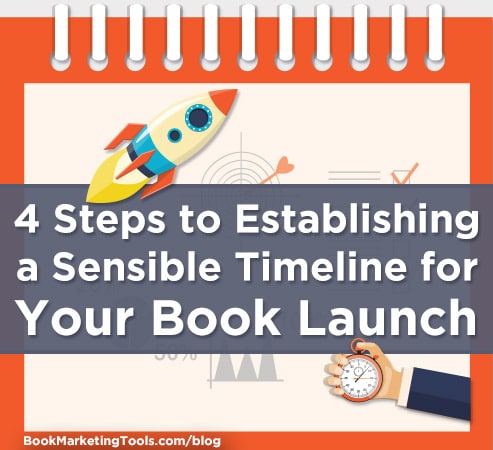There’s no doubt about it: book writing creates plenty of hair-raising, coffee-craving, nail-biting moments.
While most of us like a good adrenaline rush every now and then, a book launch is not the time to embrace a crazy, let’s-see-what-happens-next approach. It needs some structure—a sense of order.
A book launch plan needs to be bound in time.
It isn’t fluid and ongoing. It needs a start date and an end date. It needs to accommodate your launch strategy and tactics. It needs to be realistic so that you can budget your time efficiently.
So, how do you establish a timeline?
Step 1: Start by figuring out when your launch would have maximum impact.
After all, you wouldn’t release a Christmas-themed romance novel in March, a winter cookbook in summer, or a tax guide after tax season—at least not if you expect to gain traction. What you do want to do is determine whether there are any holidays, significant events, and dates that could aid or even negatively affect your launch. If there are, be sure to time your book’s release accordingly. Just imagine how many more copies of your book on settling workplace disputes you’ll sell if you launch on #NationalSlapYourIrritatingCoWorkerDay.
Step 2: Set a hard launch date.
Look, there are certain circumstances under which things could change (like the Internet breaking), but imagine how disappointed your audience will be if you’ve advertised a release date and you don’t deliver. It doesn’t set a good precedent for future releases, and it certainly doesn’t do much for building credibility or trust.
How do you figure out which day would be a good day to launch?
That depends. Some people might think you’re overthinking launch dates at this point—you launch when you’re ready to launch and that’s it. However, certain patterns start to emerge after enough research. For example, the original Harry Potter series released on Thursdays and then later at midnight on Saturdays in the U.K. The majority of new Apple products are announced on a Tuesday. For that, there could be many reasons. You’re not J.K. Rowling or Apple, though. You don’t necessarily have a large, unified publicity push behind your book, so those reasons might not make sense for your launch.
So then, should the day you pick matter?
Absolutely! Consider that several book releases might be happening on the day you’ve chosen, all within the same genre or niche. Do you want to fight for attention alongside those authors or will launching on a different day give you an advantage? Perhaps target market research indicates your readers usually play catch-up on Mondays and reserve the weekends for downtime, effectively making those days a no-go for book releases.
Over time, you might even start to see sales patterns surface for other books you’ve published. Wouldn’t it then make sense to launch a new title on a day when you tend to sell more books—when your target readership is more active and engaged with you and the manuscript you’ve worked so hard to write?
Yes. Yes, it would.
Step 3: Plan backwards from your launch date, taking your strategy and chosen tactics into account.
All this means is figuring out how much time you need to implement your promotional activities and then working your way back from release day to create a realistic schedule.
While you’ll discover there are hundreds of effective book launch tactics you could use to promote your book the reality is you can’t do them all. Prioritizing your activities and budgeting your time wisely will ensure you don’t commit to too much and overwhelm yourself during crunch time.
Step 4: Consider post-launch activities and add them to your timeline.
While it may be tempting to take a break after you’ve hit the publish button, a launch plan doesn’t end on launch day—unless you want your campaign to come to a screeching halt. There needs to be follow-up to keep the momentum going, to keep your audience engaged, and to make sure your book doesn’t slip into obscurity. Ultimately, you want a smooth transition from the release of your book into your regular writing and marketing schedule.
A small caveat: If you’re incorporating print books into your offering and using print-on-demand services, there’s a chance your pre-order period and hard launch date will be out of sync with your paperback’s availability. Unlike traditional publishing houses, you have little control over the process. This doesn’t help when you want physical copies to give to reviewers, bookstores, or attendees at your launch party. Plus, you’ll want to order a proof copy to make sure your book looks the way you want it to look. To avoid utter chaos, be sure to research your print-on-demand options. You’ll want to check how far in advance you need to upload your book file, how the approval process works, and how long it usually takes for your book to appear in the relevant distribution channels once you’ve approved the proof.
The bottom line is this: a successful launch is about carefully coordinating all the moving parts of a well-thought-out strategy. Now that you know how to go about creating a timeline, you can start scheduling in the activities and tactics you have planned so that you know exactly when certain tasks needs to be completed.
Now it’s over to you…
Have a question, tip, or comment on book launch timelines? We’d love to hear from you, so drop it in the comment box below. Be sure to subscribe to our blog to learn more about book launches. We have lots of great stuff headed your way. If you want a sneak peek, download our free book launch success checklist—it’s not just your everyday checklist!


